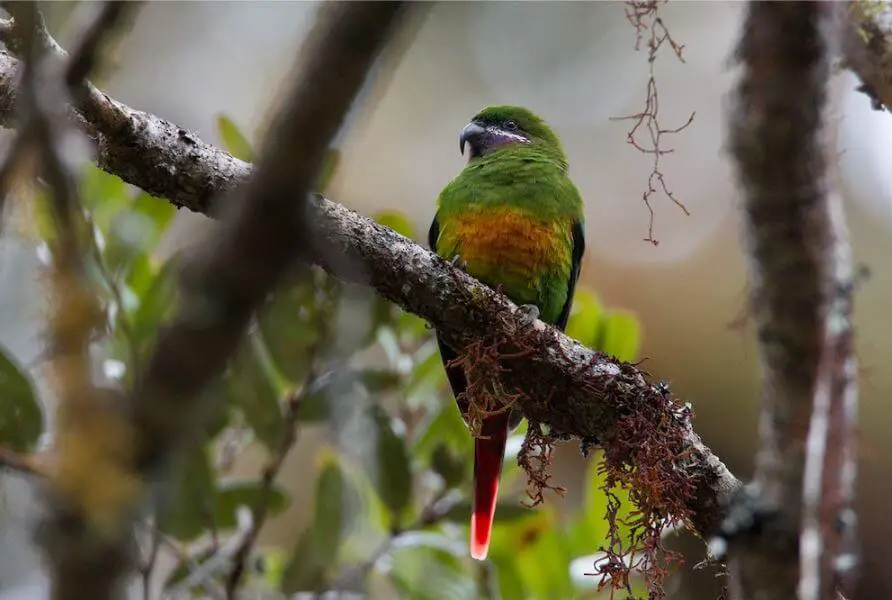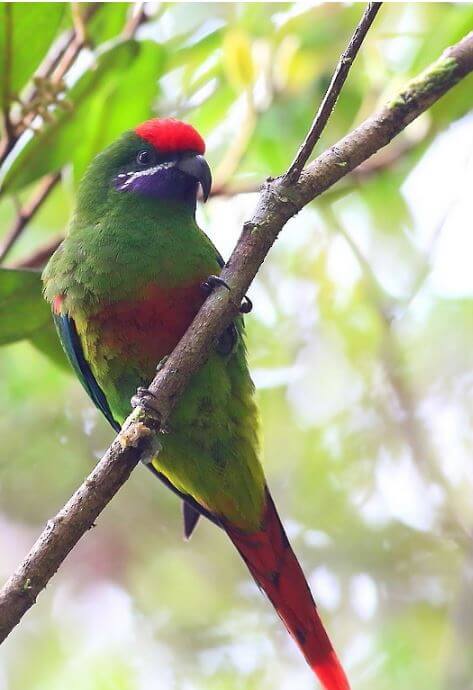
Plum-faced Lorikeet 15–17 cm; 16–26 g. Bill Black, the entire crown above a line through eye red; face below eye plum purple, with a double string of white flecks from lores under the eye to ear-coverts;
the postocular area adjoining sides of neck, nape, upperparts, and tail dark green; primaries blue; underparts yellowish-green, but sides of breast and underwing-coverts red, belly and lower flanks orange-red, yellow on sides of under tail-coverts; yellow band across undersides of secondaries; tail tipped reddish pink, underside all reddish.
The Plum-faced Lorikeet Female has no red on the head. Immature similar, with black edges on upper parts, facial pattern less obvious. Race major larger, with a more extensive red tip to tail; Grandis similar but lacks orange-red on belly and flanks.
Systematics History
Editor’s Note: This article requires further editing work to merge existing content into the appropriate Subspecies sections. Please bear with us while this update takes place.
Proposed race intermedius (from C New Guinea) synonymized with grandis. Three subspecies were recognized.
Subspecies

Plum-faced Lorikeet
SUBSPECIES
Oreopsittacus arfaki arfaki Scientific name definitions
Distribution
Oreopsittacus arfaki major Scientific name definitions
Distribution
Oreopsittacus arfaki Grandis Scientific name definitions
Distribution
Distribution
Editor’s Note: Additional distribution information for this taxon can be found in the ‘Subspecies’ article above. In the future, we will develop a range-wide distribution article.
SOURCE: Video Ark
Habitat
Montane mist forest at 2000–3750 m, including disturbed Nothofagus- Podocarpus forest. Occasionally found as low as 1000 m.
Diet and Foraging

Plum-faced Lorikeet
Nectar and perhaps pollen of Dimorphanthera cf. cornuta, flowers, and fruits of Schefflera, berries; noted to feed not only in the crowns of trees but also on small fruits on lower growth inside the forest; usually in pairs.
Sounds and Vocal Behavior
The commonest vocalization a crisp, high-pitched triple-noted “tsi-tsi-tseet”, sometimes run together to become a longer Twitter. Also, single “tseet” notes.
Breeding
Mating display observed in Jun, and breeding condition Plum-faced Lorikeets in Aug–Oct. No other information.
Conservation Status

Plum-faced Lorikeet
Not globally threatened. CITES II. Fairly common but difficult to observe. Regular around Tari Gap, Papua New Guinea.
Other Type of lorikeet:




















